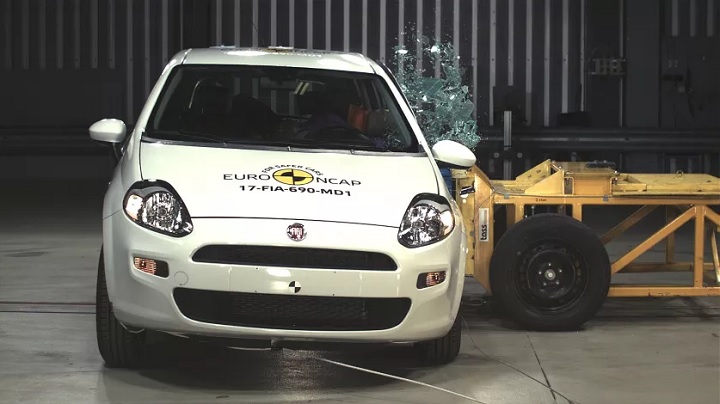
Euro NCAP says 2017 was an encouraging year for new car safety, with ‘greater and greater’ levels of life-saving technology featuring in new models.
Euro NCAP’s five-star safety rating system is designed to help consumers compare vehicles and identify the safest choice for their needs. The system is based on a series of tests which represent accident scenarios that could result in injury or death for car occupants and other road users.
 Reflecting on its ‘busiest-ever year’, Euro NCAP says nearly 70 models were assessed during 2017 – with most new cars achieving the maximum five-star rating.
Reflecting on its ‘busiest-ever year’, Euro NCAP says nearly 70 models were assessed during 2017 – with most new cars achieving the maximum five-star rating.
However, the ratings of ‘facelifted’ models were generally poorer than those of newer cars, reflecting ‘a lack of advanced restraint systems and driver-assistance technologies’.
Looking at car manufacturers, Volkswagen ‘emerges with great credit’ according to Euro NCAP, with winning models in three categories.
The Polo was named the safest car in the supermini class, T Roc in the small off-road category and the Arteon in the executive class. 2017’s best overall performer was a Volvo – the large off-road XC60.
Michiel van Ratingen, secretary general of Euro NCAP, said: “Congratulations to Volkswagen. To win best-in-class in three different categories is a great achievement and underlines the company’s commitment to providing the highest levels of safety to its customers.
“More broadly, though, it is encouraging to see so many new cars performing so well in all areas of safety, and being equipped with greater and greater levels of life-saving technology.”
For 2018, a number of new technologies will feature in Euro NCAP testing, including: lane assist systems to control steering if there are potential risks; tests to reduce crashes at junctions; pedestrian AEB that works at night time; and new AEB cyclist detection tests.
Stats by the Motoring Association actually show that new car sales are down on previous years and that may be because here are many 2nd hand cars available that were sold in the last few years on private financial deals. With such a glut of nearly new models its bound to bring the price down.
Probably as a result of this some of the more expensive vehicles are being drastically or rather dramatically reduced in price some by up to £7000. It seems that there is a reluctance to purchase an expensive all singing and all dancing machine.
Especially when one considers that the safety features are in question mainly because they can be overridden or turned off or simply ignored. The question then arises that
if they are designed particularly to make driving a lot safer why can they be so constructed not to be used and at an increased cost to purchase. What added value do they then give. None. I think that the car manufacturing industry made an error their,
bob craven
0
I have a sixteen year-old car and for the first time, I’ve just tried to check, its safety rating, however it is not listed by ENCAP, although the corresponding Australasian system (ANCAP) rates it as 1 star = ‘very poor’ …….. good job the brakes work then.
As I said earlier, whether it’s top rated or low rated, a crash will probably still hurt somebody.
Hugh Jones
0
Basic car safety levels are rising all the time due to pressure from consumer based testing regimes which introduced Euro-NCAP all those years ago when the automotive industry and governments of the day were lax about safety. I think it is fair to say that it is much harder to buy an unsafe new car these days although less than 10 years ago the odd new car still failed the elk test avoidance manoeuvre.
So safety ratings are still of relevance to some people buying a new car today but just one of many factors and perhaps of lesser importance than previously. But that still leaves millions of older cars on the road. It wasn’t so long ago that larger cars at the luxury end of the market had good safety ratings but many small cheaper cars of the same vintage faired poorly in safety/crash tests. If buying an older second hand car it is probably still worth checking its safety rating before you buy. You may be surprised.
Pat, Wales
+3
A bit fatalistic perhaps Andrew? Would such an attitude not lead to a compromise in the final choice of the vehicle – after all, 99.99% of of the time (ideally 100%) spent in our cars, we’re not actually crashing!
Hugh Jones
0
(to Hugh):
This customer does! 🙂
Andrew.
Andrew Fraser, Stirling
--1
re-the second para…. do customers actually do a ‘safety comparison’ as presumed, or are they swayed by more immediate and practical features i.e. comfort, convenience, driveability, space etc? I presume even the lowest rated vehicle is a not actually unsafe and realistically a crash in any car is probably going to hurt anyway, so – best avoided really… in any vehicle. Also, I wonder if there’s an element of ‘risk compensation’ with customers who consciously choose the highest safety rated car.
Hugh Jones
+2